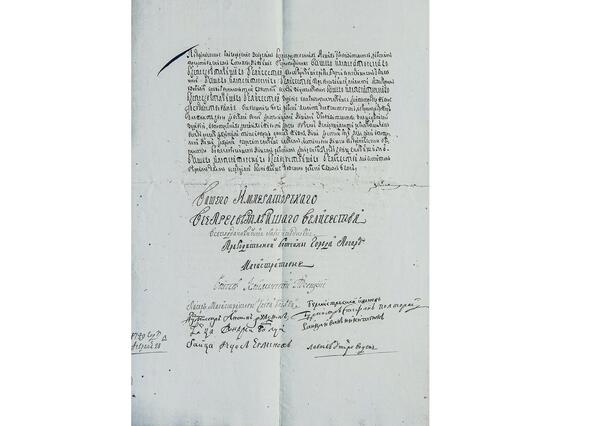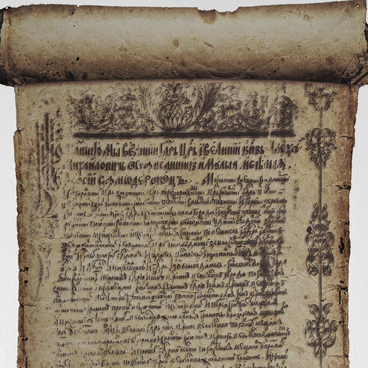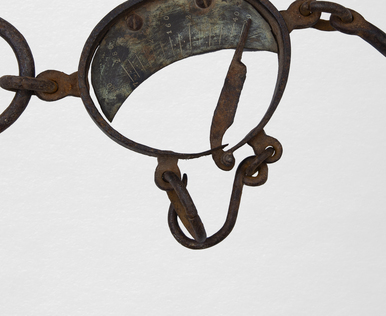In the early 18th century, Pogar had a dinarchy. The city belonged to the Starodubsky Regiment. That was the name of both the territory and the military unit formed there. Therefore, it was under control of sotniks (lieutenants of Cossack troops). But by the Magdeburg law, granted to Pogar in 1666 by Tsar Alexei Mikhailovich, the city also had a body of local self-government, the Magistrate. Both a sotnik and a magistrate headman called “voyt” could govern the city.
In 1744, Klimentiy Pesotskiy, a voyt of Pogar, and his burghers sent letters to the General military office. He referred to the letter of grant “About the Old-Time Magdeburg Law” of the Tsar Alexei Mikhailovich, received by Pogar back in 1666. He said that the royal decree was not fulfilled, and the magistrate was under the command of sotniks.
In 1749, the Magistrate of Pogar together with the townspeople sent a letter to Empress Yelizaveta Petrovna. Klimentiy Pesotskiy, a clerk of the magistrate Savva Barluy, “raytsi” (assessors), “lavniki” (associate judges) and merchants signed the letter.
The citizens of Pogar pointed out that the magistrates in the cities of Nizhyn and Chernigov according to decrees of “Her Imperial Majesty, as a petitioner and other townspeople affairs are kept by the magistrates themselves; and they are now without a voyt and townspeople in the city of Pogar in the power of the letter of grant… are offended.”
The townspeople gathered confirmation of the Tsar’s letter of 1666 and asked to refuse the sotnik’s request, who demanded “not to exclude these Pogar townspeople from the jurisdiction of the sotnik.”
Empress Yelizaveta Petrovna by her decree commanded, “to have a Magistrate in the town of Pogar by the law of Magdeburg.” The regimental headman and sotnik were instructed not to interfere with either the city administration or the court, and to perform the same duties as the ordinary citizens of Pogar.
After that decree, the Magistrate of Pogar was restored. Klimentiy Pesotskiy remained to serve as a voyt, Savva Barluy was appointed as a clerk. The Magistrate consisted of 45 people, among whom were 3 stewards, 3 assessors, 3 associate judges, a city governor, a supervisor of private plants, 5 police sergeants, 2 keepers of the ferry across the Sudost river, 2 quarter sotniks, 8 charge hands and 6 “magistrate stolniks” — cooks. In addition, the magistrate included seven leaders of craft guilds.
In 1744, Klimentiy Pesotskiy, a voyt of Pogar, and his burghers sent letters to the General military office. He referred to the letter of grant “About the Old-Time Magdeburg Law” of the Tsar Alexei Mikhailovich, received by Pogar back in 1666. He said that the royal decree was not fulfilled, and the magistrate was under the command of sotniks.
In 1749, the Magistrate of Pogar together with the townspeople sent a letter to Empress Yelizaveta Petrovna. Klimentiy Pesotskiy, a clerk of the magistrate Savva Barluy, “raytsi” (assessors), “lavniki” (associate judges) and merchants signed the letter.
The citizens of Pogar pointed out that the magistrates in the cities of Nizhyn and Chernigov according to decrees of “Her Imperial Majesty, as a petitioner and other townspeople affairs are kept by the magistrates themselves; and they are now without a voyt and townspeople in the city of Pogar in the power of the letter of grant… are offended.”
The townspeople gathered confirmation of the Tsar’s letter of 1666 and asked to refuse the sotnik’s request, who demanded “not to exclude these Pogar townspeople from the jurisdiction of the sotnik.”
Empress Yelizaveta Petrovna by her decree commanded, “to have a Magistrate in the town of Pogar by the law of Magdeburg.” The regimental headman and sotnik were instructed not to interfere with either the city administration or the court, and to perform the same duties as the ordinary citizens of Pogar.
After that decree, the Magistrate of Pogar was restored. Klimentiy Pesotskiy remained to serve as a voyt, Savva Barluy was appointed as a clerk. The Magistrate consisted of 45 people, among whom were 3 stewards, 3 assessors, 3 associate judges, a city governor, a supervisor of private plants, 5 police sergeants, 2 keepers of the ferry across the Sudost river, 2 quarter sotniks, 8 charge hands and 6 “magistrate stolniks” — cooks. In addition, the magistrate included seven leaders of craft guilds.



